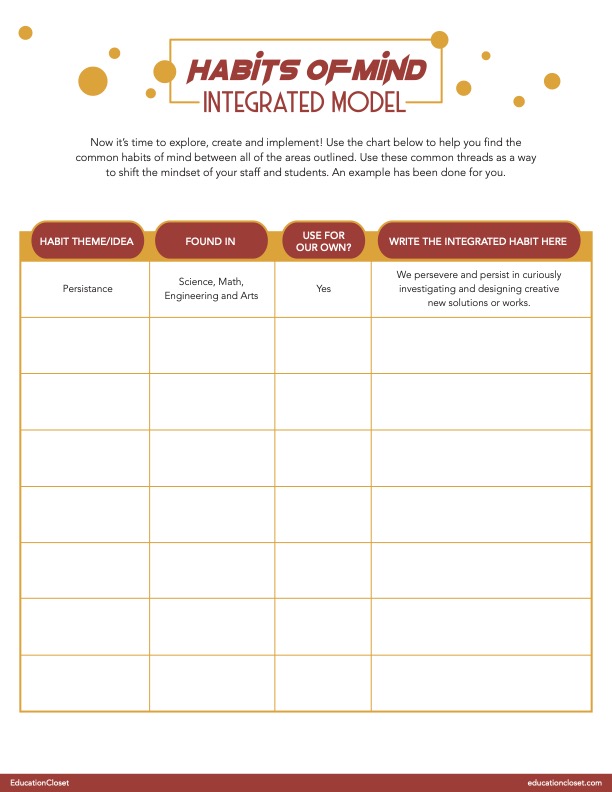JOIN US FOR THE 2025 ARTS INTEGRATION & STEAM CONFERENCE – LEARN MORE
Have you ever heard someone tell you that it takes 21 days to form (or break) a habit? Well, scientific studies have determined that to be unfounded.
When it comes to something easy, such as grabbing a coffee at your local Starbucks on your way to school, it might take only a few days for a habit to form. But if it is a habit that is challenging, studies have shown that it may actually be more like 66 days. Or for very challenging habits, it could take up to a year!
Nearly all successful people, regardless of their profession, have mastered these habits. This makes teaching the Habits of Mind crucial as we strive to teach the whole child. Since they are cross-curricular, they can be applied to all subjects and grade levels.
These habits are not as easy to master as that daily Starbucks stop, so it is important that the language and mindset is woven throughout instruction. This way, students have an opportunity to practice frequently to help them become automatic. Additionally, it results in resilient students who are able to tackle real-world problems without giving up.
Many versions of Habits of Mind for students have been researched and published.
In the mid-’90s, Robert Marzano’s Dimensions of Learning was introduced to many educators. Without a doubt, it was a very effective way to approach and break down the components of teaching a unit. Productive Habits of Mind, or “Thinking about One’s Thinking” was the fifth of his 5 Dimensions of Learning. Furthermore, Marzano broke these habits down into three categories: Self-Regulated Thinking, Critical Thinking, and Creative Thinking.
In 2003, Harvard School of Education’s Project Zero unveiled eight Studio Habits of Mind. (Develop Craft, Engage & Persist, Envision, Express, Observe, Reflect, Stretch & Explore, Understand Art Worlds). These are habits that artists use but they can also apply to all subject areas as well.
Although it is not called “Habits of Mind”, Carol Dweck’s 2007 work on Growth Mindset can be placed in the same category. Her book, Mindset: The Psychology of Success kicked off a Growth Mindset movement in many schools, empowering students to reframe their thinking by teaching how the brain grows from doing challenging things.
While all of the above habits overlap and set students up for success, this guide provides specific resources to teach the 16 Habits of Mind based on ASCD’s book Learning and Leading with Habits of Mind: 16 Essential Characteristics for Success by Costa and Kallick, 2008. They can easily be adapted to include the other Habits of Mind. You will notice that there are many intersections since regardless of the type of habit, they all relate to metacognition.
How Can I Squeeze This Into My Already Packed Curriculum?
We know time is the enemy, and we try to teach more and more content. Just a few minutes of routine Habits of Mind thinking a day is very beneficial. Not only is it quick, but it reaps great rewards because students who apply the habits are more successful in your content and activities.
Moreover, this quick routine works well as a series of Morning Meetings, or as a quick introduction at the beginning of class. This way, students have a habit in their mind as they work through your lesson. As you notice students using habits of mind, point it out, explain what you see, and how it may connect to future successes and praise them.
This will help students to notice them on their own and will encourage them to use them more often since they will start to recognize the pattern of success that they bring.
Habits of Mind are also good to point out if you notice that things are starting to fall apart during a lesson or activity. Stop and point out the challenge you’re observing and relate it to a habit of mind that is not being utilized. Then, the following day, start with a mini-lesson on that Habit of Mind.
Remember, forming a challenging habit takes lots of repetition, so the more real-time examples a student can see, the better. Use common language and be very specific when you point out examples, and you will notice that students will begin to do the same. Then, students can be more intentional about applying the habits across subject areas.
Hype or Help?
Obviously, incorporating and teaching through a set of mindset principles is an important part of the education process. But are the Habits of Mind hype or do they really help in and out of the classroom?
In the video below, we explore each of these sets of Habits and break down why they have been outlined for each content area. Each content area is unique, but all contain common intersections for mindsets.
Integrated Habits of Mind
The question naturally becomes: why don’t we integrate across the Habits of Mind? After all, we don’t teach in isolation and if a Habit of Mind is good for one area, it stands to reason that it is probably useful in another. Isn’t that the point?
That’s why it’s important to look for the common threads in each of the content Habits of Mind and work towards weaving them together to create a cohesive set that works across all classrooms in your school.
In Action: Brainsweat
One technique to begin integrating the Habits of Mind is called Brainsweat. During “brainsweat” time, students have 7 minutes to grapple with a challenging word problem. The goal is not to necessarily finish the problem in that amount of time, but to spend that time ONLY focusing on the problem and possible ways to solve it.
Students can also mark it up with questions they have, what is “stumping” them, and words they need to clarify. When time is up, students are assigned groups where they can share ideas, come to a consensus on the answer, and determine which strategy is the most effective in finding the answer.
Teaching the 16 Habits of Mind with Pixar (and similar) Shorts
One way to teach the Habits of Mind is through quick video clips or picture books. This list provides at least one video clip to match each of the 16 Habits of Mind.
You can use the accompanying Student Workbook to encourage students to sketch and doodle their thoughts throughout.
Alternative Video Clips and Ideas
Need more? This website has a video clip for each of the Habits of Mind. So if you need an alternative to better match your grade level, or if you need more practice, check them out!
Weaving Habits of Mind into Lesson Planning
Habits of Mind can also be used as an integrated instructional tool to address different learning styles, abilities, and interests. These habits can help develop problem-solving skills, infuse higher-order thinking attributes, and promote collaboration within the lesson plan format.
Try using this format as you plan your next lesson:
- Identify the topic of study
- Clarify standards and objectives to be used
- Brainstorm activity ideas for each Habit of Mind
- Determine the assessment
- Make clear the purpose of the lesson
Here’s an example of what this might look like in practice:
Habits of Mind Cards
Be sure to download these free Habits of Mind Cards that work wonderfully as a bulletin board display.
Having these resources on the wall and within the student workbook will undeniably help students to see the Habits of Mind frequently, helping them to form the habits more quickly.
Resource visuals on the wall are not as effective without an explicit mini-lesson on each, so make sure to pair your bulletin board with the instruction.
Building a Common Connection
Mindsets in general are important to understand and cultivating habits within those mindset is extremely helpful. If we advocate for our students receiving a well-rounded and robust learning experience, we can no longer teach in silos or as if our own content areas are the only lens through which our children see. Let’s work together to build a creative mindset in all classrooms with the Habits of Mind.







